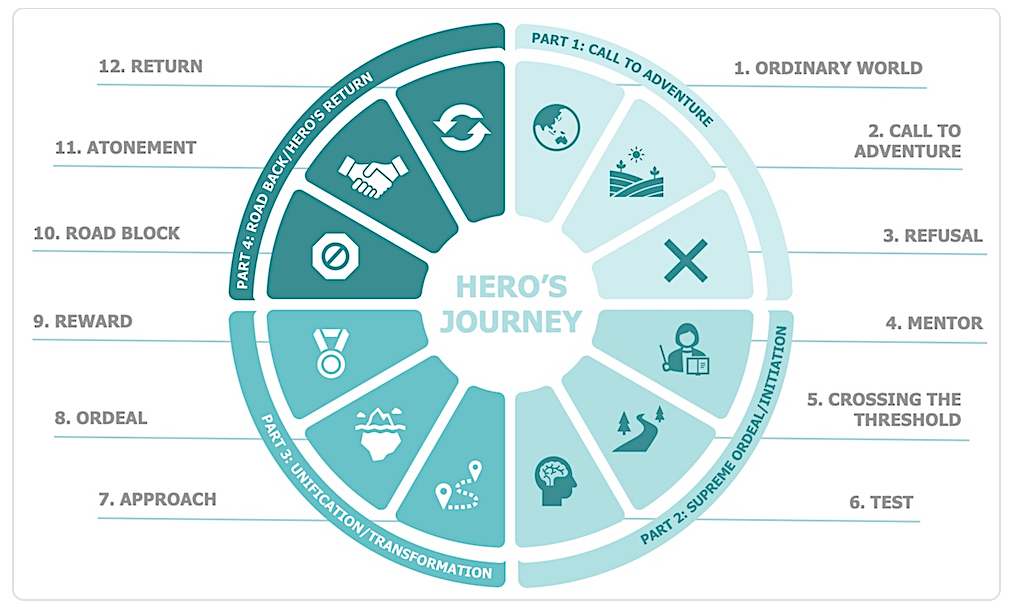People often ask me how I remain confident and steadfast despite the many challenges I have faced and continue to experience on my path to success. I believe my courage and resilience come from viewing my life as a story unfolding, full of highs and lows and unexpected detours, but with a guaranteed happy ending if I keep going. I accept there will be challenging times, but I believe every obstacle I encounter will be worth the reward of reaching my desired destination. The story isn’t over until I have landed where I am meant to be. It hit me recently, I live my life according to Joseph Campbell’s Monomyth The Hero’s Journey.
The Hero’s Journey is a common narrative archetype, or story template that involves a hero who goes on an adventure, learns a lesson, wins a victory with that newfound knowledge, and returns home transformed. Think of your favorite movie. The main character usually goes through an experience similar to a hero’s journey. First, they get inspired, then some dramatic event causes them to break down or lose hope, but by the end of the film, they triumph and become wiser and stronger and ready to take on their new life.
I traveled a parallel path during my transition from the for-profit to the non-profit sector. I had successfully climbed the corporate ladder, but I felt called to do more and positively impact the world. I understood changing my career would be hard at times, but I knew I had to put service over stature to be genuinely fulfilled. When things became tough, I would tell myself I just had to get past the middle of the movie, where everything appears to be falling apart, and the character feels like giving up. Accepting every phase of my journey provided me with the grit and determination I needed to eventually land my dream job at my favorite charity.
Viewing your professional path through the lens of the hero’s journey can help you build the career you want as well. The key is to familiarize yourself with the steps in the hero cycle so you can reference them when you need the courage, strength, and motivation to keep moving towards something better.
This is a powerful and effective tool for change, whether you are going after your ideal job, transitioning out of a career that no longer makes you happy, or starting your dream business.
Campbell laid out 17 total stages of the hero’s journey structure. However, I am referencing the popular twelve-step adapted version created by Hollywood executive Christopher Vogler.

1. Ordinary World
This step refers to the hero’s everyday life at the story’s start, before the adventure begins.
2. Call to Adventure
The hero is faced with something that makes them begin their adventure. This might be a problem or a challenge they need to overcome.
3. Refusal of the Call
The hero attempts to refuse the adventure because they are afraid. This could be because they don’t feel they have the skills to take on the quest, or they don’t want to leave the life they know.
4. Meeting with the Mentor
The hero encounters someone who can give them advice and ready them for the journey ahead. The mentor guides the hero in gaining the supplies and knowledge needed to embark on the adventure.
5. Crossing the First Threshold
The hero leaves their ordinary world for the first time and crosses the threshold into an adventure.
6. Tests, Allies, Enemies:
The hero learns the rules of their new world. During this time, they endure the strength of will tests, meet friends, and come face to face with foes.
7. Approach
The hero draws closer to the story’s center and the special world. Setbacks occur, sometimes causing the hero to try a new approach or adopt new ideas.
8. Ordeal
The hero experiences a major hurdle or obstacle. Through this struggle, the hero undergoes a process of death and rebirth, figuratively or literally.
9. Reward
After surviving the ordeal, the hero earns their reward or accomplishes their goal. The object of the quest may be an actual treasure or a symbolic achievement.
10. The Road Back
The hero begins their journey back to the ordinary world or continues onward to an ultimate destination, but their trials aren’t over yet.
11. Resurrection
The hero emerges from the special world fundamentally changed by their experiences.
12. Return with Elixir
The hero brings their knowledge or the “elixir” back to the ordinary world, where they apply it to help all who remain there.
Using the 12 steps in The Hero’s Journey can give you the drive and resilience necessary to reach your professional goals and architect the career you truly desire. It will provide you with the bravery to venture into the unknown, the power to continue when things become difficult, and the determination to reach your goal no matter how ambitious it might be or how long it takes to achieve what you set out to do.
The best part is this journey can be recycled anytime you feel called for more, face a new challenge, or want to take your career to a new level.
Always remember, if you are not happy or fulfilled, the story isn’t over. You can still write your happy ending if you keep going.


